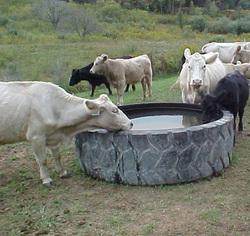These tanks work GREAT!!! We use them everywhere!
On the leaching: I personally feel this is a big joke so do your own research. I got in some trouble in this community over using the tanks as garden planters, so lets discuss the finer points of installing these tanks.
First you need to trench your water system to the center point of where you want your tank. This can be from a well source, gravity feed, really any pipe you would traditionally run water through works. We use the standard 2" PVC trenched from a well source to all of our tanks. The pipe is laid deep so not to freeze. You put a 90 degree elbow up and install the riser pipe (with coupler attached). The edge of the coupler should come just a smidge over where the top of the concrete goes. This is because if the exposed pipe in the tanks gets busted for whatever reason you can reinstall new fittings by chipping out to old pipe from the coupler and putting new riser and fittings in.
So now installing the tank. Level the pad site so that the tank will sit level. Remember that the cut on the tire is not always level so some diligent planning is required so you aren't constantly spilling water. Place the tire on the level spot. This will typically need some sort of machinery to do as the tires are very heavy. Get enough sacks of concrete to fully fill the cavity where the tire sits. Fill concrete up so that there is a good seal. DO NOT USE WET CONCRETE!. Tamp the concrete in or leave it loose, a little bit of tamping seems to help but we've put them in both ways.
Install the riser and fittings. This is as simple as running down to the hardware store and getting a float valve to put on top of the riser. Get a float and attach. DO NOT BUY COPPER FLOATS! They are incredibly expensive and break just as easy as any other. The best and cheapest float is 2 or 3 old laundry detergent bottles tied to the lever on the float valve. You have to replace them more often (once about every other year), but they are free, it's recycling, do what you want.
Turn the water on!
The concrete will self cure and harden perfectly fine.
Best damn water tank ever. I have seen them shot multiple times with 30-06 rounds, and the rubber "heals" itself. I have never seen leakage on a tank, but I'm sure there are always some that have been really worn down or have had massive punctures. It's best to check the tire out, just like checking out used tires to put on the farm truck.
If you get whole tires and need to cut the top out...I have seen them taken off with sawsalls and chainsaws. The chainsaw method is really tough on machines though, especially with the metal that is inside the tire. Cut the tire on the apex of the corner going from tread to wall at a 45 degree angle. You may or may not need a grinder wheel to smooth off rough metal edges once you get it cut.
The tops can be used for all sorts of things. We use them as garden planters. Weed suppressors around trees. Parts of erosion control methods. And I've seen them in wind breaks.
Google search some schematics and you will find LOADS of information on the best way to install. We have used everything from a 6 foot tire to a 20 foot tire. Process is the same, the heavy lifting a bit different.

GOOD LUCK!!





















 , not the tire in its present form...I guess I would still worry about leaching either way.
, not the tire in its present form...I guess I would still worry about leaching either way.















 2
2
















